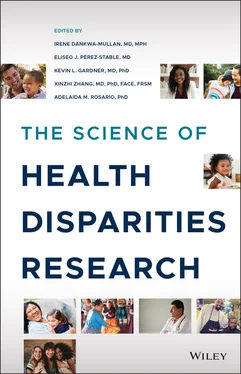In the twenty‐first century, data collection and availability have dramatically improved. Scientific advances in understanding basic biological mechanisms have transformed our understanding of etiological pathways and potential interventions to improve minority health and reduce health disparities. The creation of a critical mass of interdisciplinary investigators has made possible further development of the science of minority health and health disparities. Collaboration among all health‐related disciplines will make it possible for the next generation of minority health and health disparities researchers to advance the science. In that spirit, NIMHD is producing this book as it celebrates its tenth anniversary as an NIH Institute to further advance the science and lay the foundation for future research.
NIMHD is charged with coordinating and leading the NIH's vision and programs on minority health and health disparities research by funding research to improve minority health and reduce health disparities. The topics are broad and include the epidemiology, etiology, prevention, and treatment for all diseases across the life course for all health disparity populations. Research that advances understanding and improvement of health and disease in minority racial/ethnic groups in the United States is a primary area of interest, requiring a basic understanding of race and ethnicity in the context of science. Research to understand the causes of health and healthcare disparities, leading to interventions to reduce these disparities, is NIMHD's mandate. The training and development of a diverse scientific workforce is also part of a broad NIH mandate embraced by NIMHD. NIMHD envisions an America in which all populations will have an equal opportunity to live long, healthy, and productive lives.
1.3 Definitions and Concepts of Minority Health and Health Disparities
1.3.1 Racial/Ethnic Minority Populations
In 1997, the Office of Management and Budget (OMB) issued the Revisions to the Standards for the Classification of Federal Data on Race and Ethnicity. 2 These standards are used for federal data collection purposes in the decennial US census, national household surveys, many administrative forms, and in medical and clinical research. Race and ethnicity categories have been modified over the decades to reflect the evolving demography of the United States, although full understanding of the meaning of the constructs captured by these categories is lacking and the categories need ongoing refinement and study. Currently, the five categories for race are defined as: American Indian or Alaska Native, Asian, Black or African American, Native Hawaiian and Other Pacific Islander, and White. In addition, a multirace category was included for the first time in the 2000 census. There are two categories for ethnicity: “Hispanic or Latino” and “Not Hispanic or Latino” and the question of ethnicity is posed before the race categories. The 2020 census plans to ask about family background for all respondents and continue to collect information on nation or US territory of origin for Hispanics/Latinos, Other Pacific Islanders and Asians, as well as tribal affiliation for American Indians/Alaska Natives. We consider that standardization of race and ethnic categories is an essential component of minority health and health disparities research and recommend using the census nomenclature and definitions as the starting point for specificity and standardization in the field.
1.3.2 Minority Health and Minority Health Research
NIMHD defines minority health research as the study of all aspects of health and disease in one or more OMB‐defined racial/ethnic minority populations. Minority health research can include comparative research to examine and understand better or worse health outcomes in a racial/ethnic minority group relative to other groups. For example, greater prostate cancer mortality in African American men compared to White men, longer life expectancy in Asian and Hispanic/Latino populations compared to the general population, and higher rates of diabetes in all minority groups. Minority health research also encompasses within‐group variation in health, such as asthma prevalence and morbidity in Puerto Ricans compared to Mexican Americans, and variation in cancer rates among American Indians from different regions. Minority health research can also address health conditions or risk and resilience factors specific to or disproportionately found in specific racial/ethnic minority groups, such as pain management in African American sickle cell patients and the use of native or traditional medicines or health practices by American Indians/Alaska Natives and other population groups.
An overarching common theme for all racial/ethnic minorities in the United States is to share a common experience of having been subject to some level of discrimination or social exclusion, which vary across groups and by socioeconomic status (SES) and need to be placed in historical and current contexts. The historical trauma experienced by American Indians as they were displaced from their lands and restricted to reservations, and the legacy of slavery for Black Americans carry a special burden. Moreover, societal discriminatory practices, like redlining to support residential segregation, have affected racial/ethnic minorities and are a fundamental cause that must be understood in order to reduce health disparities.
1.3.3 Health Disparities and Health Disparities Research
NIMHD defines a health disparity as a health difference, based on one or more health outcomes, that adversely affects defined disadvantaged populations. According to the legislation that created NIMHD, a health disparity population is characterized by a pattern of poorer health outcomes, indicated by the overall rate of disease incidence, prevalence, morbidity, mortality, or survival in the population as compared to the health status of the general population. NIH‐designated health disparity populations were defined in this legislation and the authority to modify these designations was given to the director of NIMHD in consultation with the director of the Agency for Healthcare Research and Quality (AHRQ). Currently designated health disparity populations include the racial/ethnic minority groups mentioned above, populations of less privileged SES or poor persons from any race/ethnic group, under‐served rural populations, and sexual and gender minorities. Health disparities research is devoted to (i) understanding determinants that cause, sustain, or mitigate health disparities; and (ii) how this knowledge is translated into interventions to reduce disparities.
NIMHD's definition of health disparities emphasizes an adverse difference in populations with a social disadvantage. From the NIMHD perspective, a defined difference in health outcomes between populations is not necessarily a disparity. We define disparity as a difference between a disadvantaged population and a more advantaged referent population or the general population.
By comparison, in Healthy People 2020 , the contributions of social determinants to an individual's ability to achieve good health also include sex, age, and disability. 3 Healthy People 2020 defines a health disparity as “a particular type of health difference that is closely linked with social, economic, and/or environmental disadvantage.” The NIMHD definition emphasizes the disadvantage of population groups, and thus all adverse health outcomes within the designated population groups are considered health disparities. The NIMHD definitions also emphasize the importance of the historical or current link to discrimination or exclusion in determining health and healthcare disparities. The contributions of biological mechanisms, healthcare access and quality, and interventions to ameliorate disparities also need to be considered.
Читать дальше












